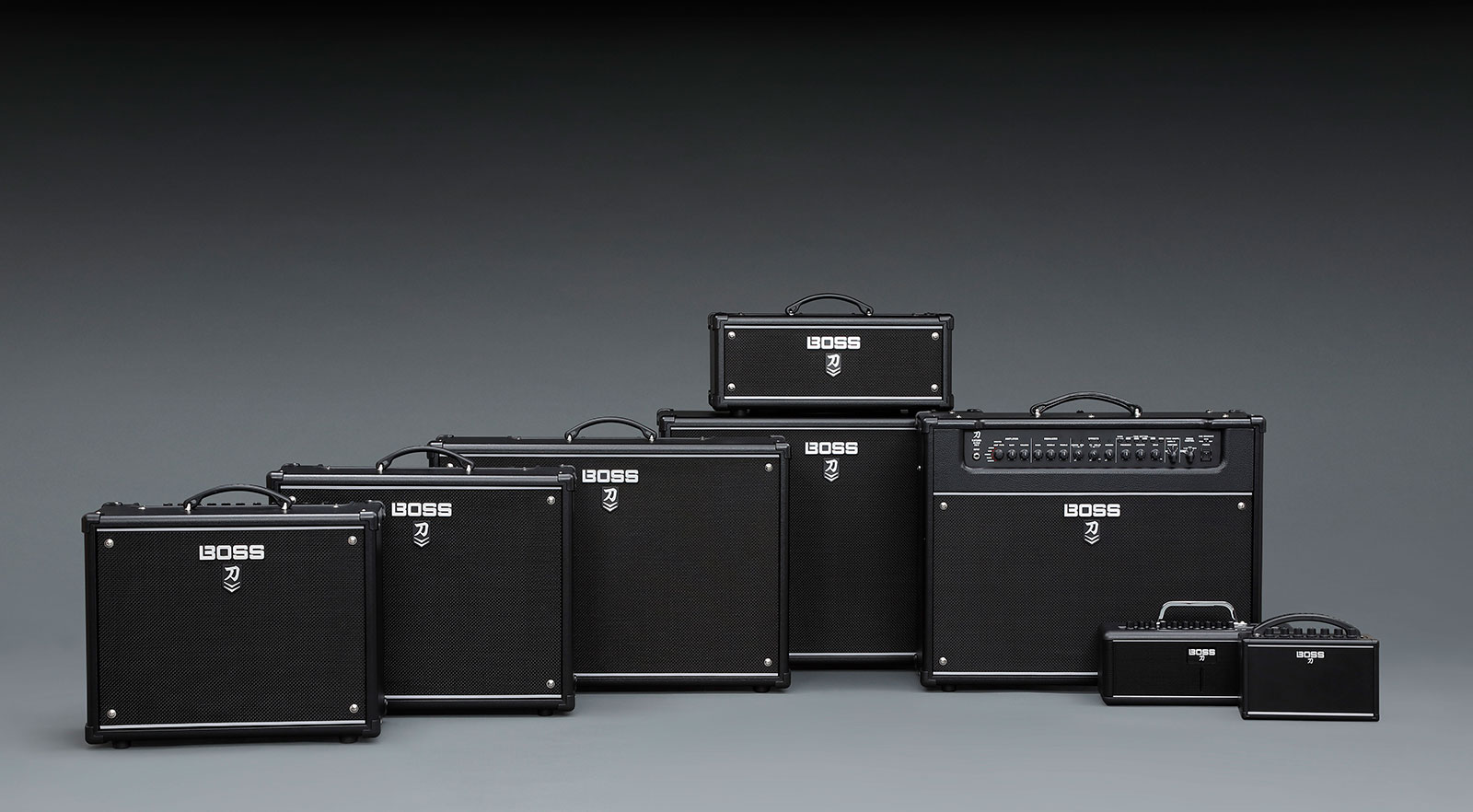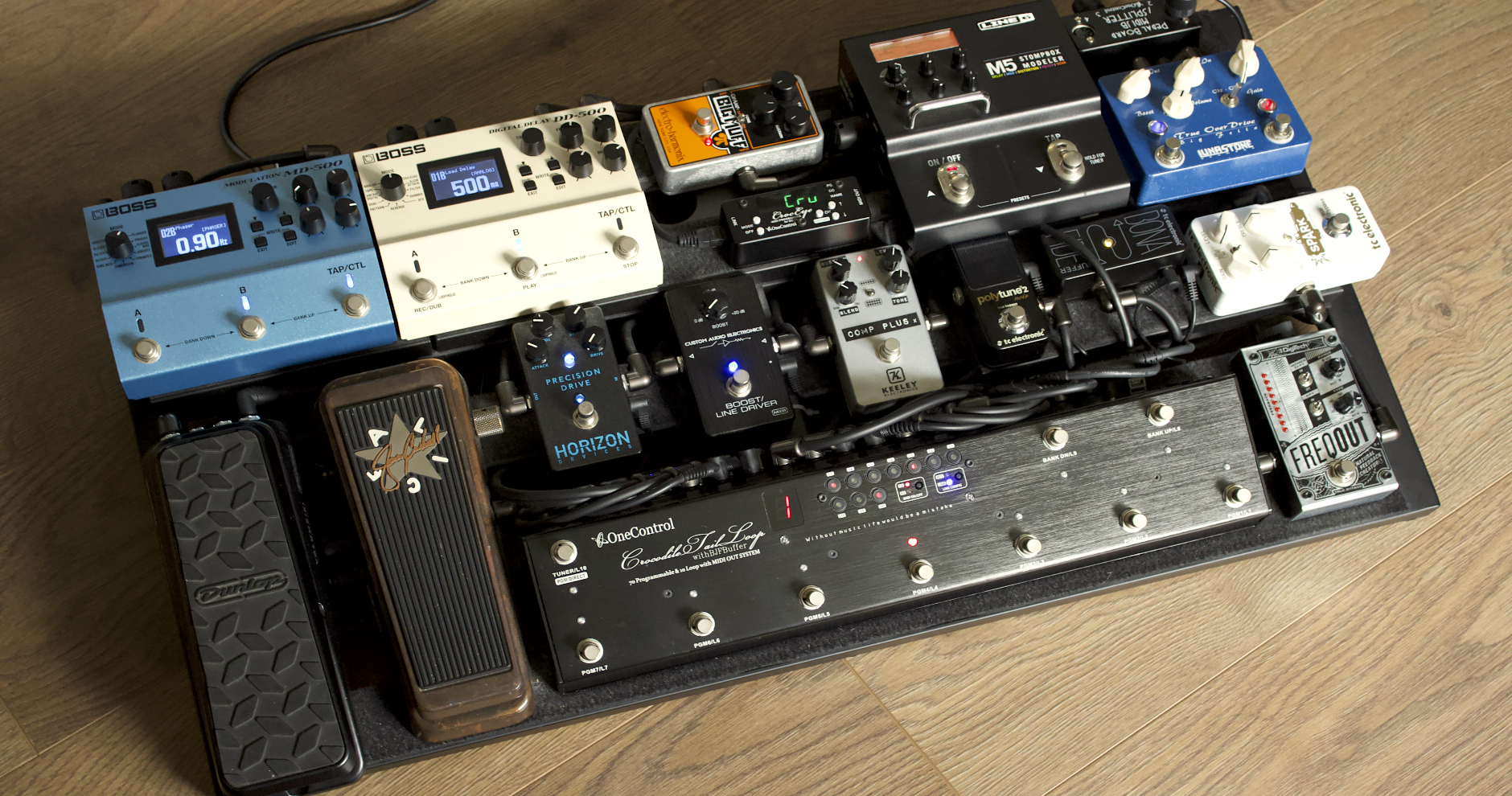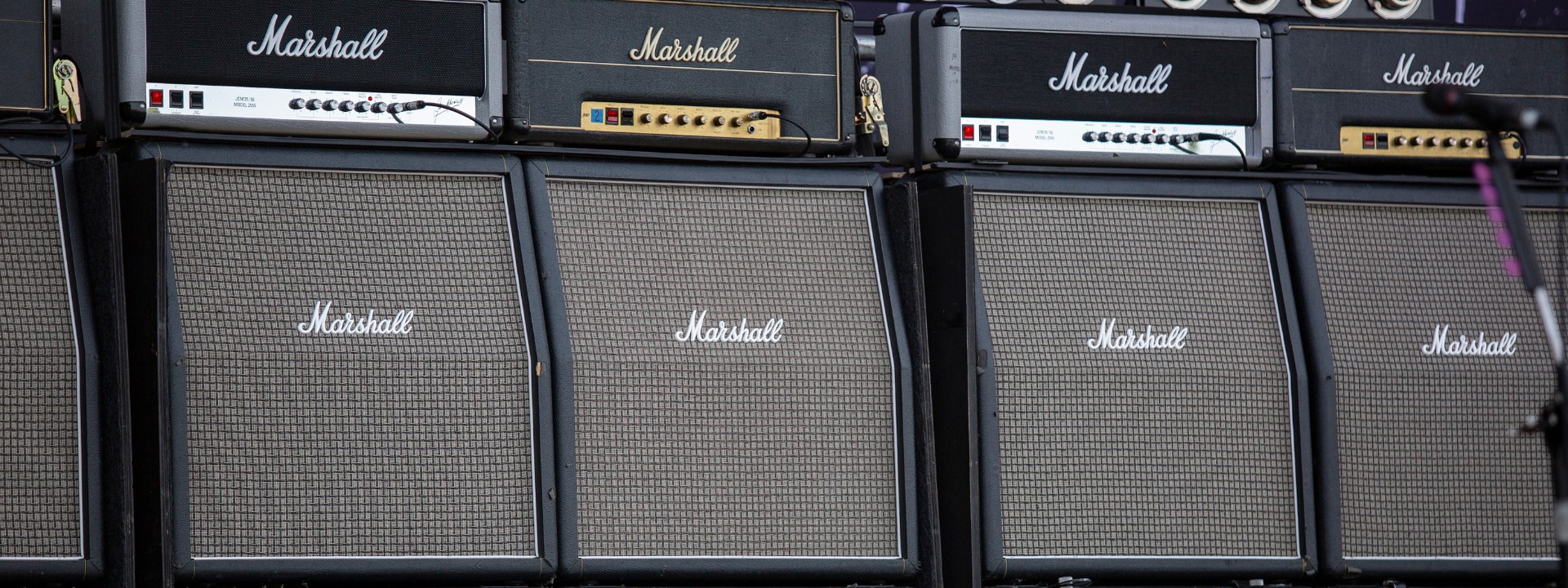Solid State Distortion
Another way of achieving amp distortion is via a solid-state amplifier. Solid-state amps rely on electronic transistors, which are much cheaper to manufacture than tubes, to generate distortion. As a result, solid-state amps are usually a more affordable option. While early models did tend to lack warmth, modern solid-state amps can deliver surprisingly good distortion at any volume.
Boss Katana
Shop All Boss Katana

Other than their comparative affordability, one of the main selling points of solid-state amps is that they generally sound as good at bedroom volume as they do when cranked. In fact, it’s possible to achieve high gain tones at very low volumes, which makes them a fantastic option for home use, or in any situation where it’s not possible to turn the amp up.
Many solid-state amps also come loaded with a plethora of great presets, which means you have a much bigger selection of distorted tones at your disposal than a tube amp. Amps like the massively popular Boss Katana range offer excellent distortion tones, with options to expand their preset libraries via external software and mobile apps. It’s true that some solid-state amps may not sound quite as organic as a traditional tube amp, but because of the multitude of other features they offer that just aren’t available on the majority of tube amps, many players are willing to look past this!
Modelling Amps
Modelling amps have come a long way in recent years. Instead of just replicating a few tones, today’s models can accurately recreate the sound and response of dozens of classic amps and cabs. Take the Kemper Profiler series, Line 6 Helix, or Neural DSP Quad Cortex. These units can “profile” (create an audio snapshot) any amp in the world with incredible accuracy. So accurate, in fact, that the resulting tones are almost indistinguishable from the real thing! Want to enjoy the searing crunch of a Soldano SLO-100, late at night, at home, without waking the neighbours? Done!
Because of their amazing versatility, modelling amps are perfect for players who like to experiment, use presets, or gig with different sounds. And as there’s no need to set up tonnes of equipment or dial in a bunch of knobs just right, they’re especially useful in recording or live settings, where consistency is key. And with modelling software often incorporating floor units and interfaces, the line between amp, pedal, and modeller is more blurred than ever before.
Modelling Amps
Shop All Modelling Amps
Pedal Distortion
Now onto the little boxes we all love. Modern distortion pedals come in all shapes and flavours, from subtle overdrive to full-on metal mayhem. And with so many options to choose from, it’s easy to see why they can become an obsession for the tone chasers out there!

Stompboxes
There are probably more distortion pedals on the market today than any other type of guitar effect, and with good reason. They’re versatile, portable, and easy to integrate into your rig. So, whether you want to add a bit of grit to a clean amp or build an entire tone around one particular pedal, the possibilities are almost endless.
From budget favourites like the Boss DS-1 to boutique tone monsters from the likes of Walrus Audio and Strymon Effects, and even the bona fide classics, such as the essential Tube Screamer or a powerful preamp pedal, there’s something here for every player. Some pedals even mimic iconic amp tones, making it super easy to get those massive sounds without lugging around an equally massive stack!
With so many distortion pedals now available, many of which are extremely affordable, it’s never been easier to coax those awesome distorted tones out of your clean or single-channel amplifier. Ultimately, a good distortion pedal could just be the easiest way to turn your sparkly clean amp into a ferocious, fire-breathing monster!
Distortion vs Overdrive vs Fuzz – What’s the Difference?
These three terms often get lumped together and used interchangeably, but they actually have pretty distinct characteristics – pick the wrong one, and you might not get the result you were hoping for! So, what’s the difference?
Overdrive emulates the natural clipping that occurs when an amp is pushed. It tends to be smoother and more dynamic, which is great for blues, rock, and pushing a tube amp out of its comfort zone!
Distortion delivers a more aggressive, compressed tone. As a result, it reshapes your guitar signal for saturated sustain and punchy attack, which is why hard rock and metal guitarists often use them.
Fuzz is the wild card of the bunch! It clips the signal heavily for a thick, buzzy, almost synth-like sound. Fuzz pedal results can be weird, wonderful and surprisingly versatile – think everything from Jimi Hendrix to The Smashing Pumpkins.
Transform Your Amp!
Let’s just say you’re using a single channel amp that really only does clean tones, yet you want some smooth, distorted lead tones for solos. You’re not going to get that sound out of the amp alone, even if you’re lucky enough to be able to turn the volume right up. This is where distortion pedals really come into their own. Stompboxes like the ever-popular Boss DS-1 Distortion provide a wide range of classic distortion tones in an affordable, pedalboard friendly package. Other options include the Horizon Devices Precision Drive and the MXR 5150 Overdrive which both feature built-in noise gates for taming the extra noise that comes with high gain pedals.
Distortion pedals present a vast array of tonal options for players, making them a perfectly valid way of generating gain in your otherwise clean amp! Do they sound as good as a cranked amplifier? With the right amount of tweaking, yes, they absolutely can! With that in mind, if you’re the kind of player who is constantly evolving their tone, distortion pedals may be the best option for you!
Overdrive & Distortion Pedals
Shop All Overdrive & Distortion Pedals
Amp Distortion vs Distortion Pedals: FAQs
What’s the difference between amp distortion and pedal distortion?
Amp distortion comes from overdriving the amp itself, often resulting in a more dynamic and harmonically rich tone. Pedal distortion is instead generated by an external effect and is typically more portable and versatile.
Can I use a distortion pedal with a modelling amp?
Most modelling amps handle pedals well, especially if they have an FX loop. Just make sure to experiment with placement and settings to find the best results.
What’s better for home practice: amp distortion or pedals?
Pedals or modelling amps are often better for home use, as you can achieve saturated tones at low volumes. Tube amps usually need to be loud to sound their best – not ideal for home use!
Are there distortion pedals that sound like famous amps?
There certainly are. Many pedals are designed to emulate specific amp tones – from Marshall Plexis to Mesa Boogies. Look for “amp-in-a-box” style pedals.
Can I use both amp distortion and a distortion pedal together?
Yes, stacking gain stages is a common technique. Just watch out for those noise levels and maybe apply some EQ to avoid a muddy tone.
What’s the best distortion option for recording?
Modellers and distortion pedals are popular for recording thanks to their consistency, tweakability, and ability to sound great at low volumes, but many players prefer to capture the raw sound of a cranked valve amp. In short, whatever works best for you and achieves the sound you’re looking for is the best option!
Do I need an expensive amp to get a great distorted tone?
Not necessarily. A good distortion pedal running into a clean amp or modeller can sound fantastic. It’s all about how you use your gear and what tone you’re shooting for.
Conclusion
When it comes to amp distortion and distortion pedals, and which is better, there really is no right or wrong answer. However you choose to create your tone is the right answer, just as long as it works for you. Of course, there are pros and cons to each method, and it’s always worth experimenting with different options to see what you can come up with. You might just be surprised!
Enjoyed this article? Find more like it in our Labs section.
Shop at Andertons









Responses & Questions